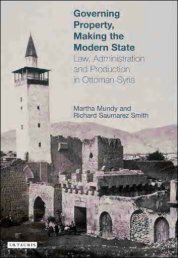The Young Turk Period, 1908-1918 - PSI424
The Young Turk Period, 1908-1918 - PSI424
The Young Turk Period, 1908-1918 - PSI424
Create successful ePaper yourself
Turn your PDF publications into a flip-book with our unique Google optimized e-Paper software.
306 <strong>The</strong> Rise of Modern <strong>Turk</strong>ey, 1808-1975<br />
needs of a much smaller empire than that which the Men of the Tanzimat had<br />
ruled. 106 A new Financial Reform Commission (Islahat-i Maltye Komisyonu),<br />
established in 1912, drastically reformed the tax system, with the tax farms on the<br />
tithes definitively abolished and the rates raised sufficiently to balance the budget in<br />
the face of rising costs. 107 <strong>The</strong> road-labor tax was increased and its application<br />
extended to Istanbul and the other large cities that had been exempt, thus spreading<br />
the burden and leaving the rural populace with less to pay than in the past. 108<br />
Income taxes were introduced to provide the municipalities with needed funds. 109<br />
<strong>The</strong> financial activities of all civil servants were placed under the supervision of a<br />
newly established Financial Inspection Commission. 110<br />
A new Provincial Administration Law (March 15, 1913) strengthened the governors<br />
and extended bureaucratic reforms similar to those introduced in Istanbul. 111<br />
Reforms in the financial and judicial systems in the provinces assigned increased<br />
responsibility to those in positions of authority. 112 <strong>The</strong> police also were reorganized<br />
and placed entirely under civilian authority, with more personnel and equipment to<br />
enable them to enforce the laws limiting the activities of the terrorist groups. 113<br />
An entirely new gendarme organization was established, on the model of that<br />
created by the foreign advisers in Macedonia, and its control was transferred from<br />
the Ministry of War back to that of Interior, again strengthening the civilian authorities<br />
in the provinces. 114<br />
Istanbul's municipality was reorganized and modernized, with a City Council<br />
(§ehir Emaneti Enciimeni) provided to help the mayor; councils of law, health,<br />
accounting, and police were introduced to provide the necessary technical advice<br />
and direction to municipal operations. 115 With the municipality now securing sufficient<br />
funds, especially from the new income taxes, it was able to carry out a vast<br />
program of public works, paving streets and sidewalks, installing electric lights and<br />
a new sewage and drainage system, and reorganizing the police and fire departments.<br />
<strong>The</strong> major city communication services, the telephone, trams, the tunnel<br />
between Beyoglu and Galata, arid the electric, water, and gas services also were<br />
modernized and extended so that by the commencement of World War I, Istanbul<br />
had caught up to the major European cities. <strong>The</strong> municipality also worked to solve<br />
the city's population problem. <strong>The</strong> refugees who had crowded in since <strong>1908</strong> and<br />
the new refugees coming after the Balkan Wars were resettled outside Istanbul as<br />
rapidly as possible: But new problems were to appear in consequence of the population<br />
dislocations of World War I. 116<br />
In addition, a series of even more drastic reform proposals made by Ziya Gokalp<br />
to further Ottoman secularization were brought to culmination during the darkest<br />
days of the war. On April 26, 1913, a new regulation established close state control<br />
over the ulema and the religious courts, requiring them to accept the authority of<br />
the secular appeals court (Mahkeme-i Temyiz) in many areas. 117 State standards<br />
of education and training were imposed on the kadis, and a new state-operated<br />
medrese was opened in Istanbul to train ulema wishing to serve as judges in religious<br />
courts. 118 State examinations administered by the seyhulislam were imposed<br />
to test their training and competence. 119 All subordinate employees of the religious<br />
courts were placed under the control of the Ministry of Justice, 120 and new regulations<br />
limited the authority of the religious courts in favor of the secular ones. 121<br />
This was only the beginning. In 1915 Gokalp proposed the complete secularization<br />
of the religious courts, schools, and religious foundations and the limitation of the<br />
seyhulislam to purely religious functions. This program was carried out by a series<br />
of measures enacted during the next two years. In late April 1916 the seyhulislam












